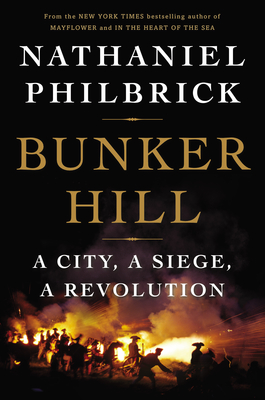Bunker Hill
A City, A Siege, A Revolution
Viking, April 2013
- A New York Times Best Seller
- Film option: Ben Affleck & Matt Damon’s Pearl St Productions
BUNKER HILL: A City, A Siege, A Revolution is the story of how a revolution is made. With verve and insight, Nathaniel Philbrick reconstructs an early American landscape in a mesmerizing narrative of the robust and blisteringly real origins of our independence. It is the story of a city — Boston — under siege, and the tragic effects on both the residents of the city and the soldiers of the occupying army — a strikingly contemporary theme. By June of 1775, Boston was fully cut off from supplies by a blockade enforced and controlled by the British. Tensions built, skirmishes erupted and would climax in the Battle of Bunker Hill, the most gruesome and bloodiest battle of the Revolution to come.
Rather than focusing on the familiar figures (Paul Revere, Samuel Adams et al), Philbrick puts a lesser known character at center stage: Dr. Joseph Warren. A prominent physician (whose patients included Quincy Adams) and just 33 years old, Warren became the glue that bound the bold ideas of the Patriot leaders to the actions of the local militia on the ground. Warren was the true leader of the troops at Bunker Hill, where he was tragically killed. Had Joseph Warren lived, some loyalists maintained, George Washington might have remained “an obscurity.”
Philbrick’s newest work chronicles the cradle of the American Revolution, Boston’s action-packed years of 1773–76. Opening with the consequences of the Boston Tea Party, Philbrick depicts the arrival of British army and naval forces, the manifestation of the royal government’s intention to quash the burgeoning rebellion in Massachusetts. Its leaders, patriots like John Hancock, Samuel Adams, and Joseph Warren, provide the drama’s counterpoise to British officials. Having deployed his characters, Philbrick launches each side’s resort to military preparations and operations, a narrative that benefits from one of the author’s several imaginative services to readers, detailing in word and map the geography of Boston and environs at that time. Another audience benefit is Philbrick’s evocation of the look of patriot militias and British regiments, which enliven his crackling accounts of military movements that produced the Battles of Lexington, Concord, and Bunker Hill. Displaying, as in Mayflower (2006) and The Last Stand (2010), a superior talent for renewing interest in a famed event, Philbrick will again be in high demand from history buffs.
– Booklist
Like a masterly chronicler, [Philbrick] has produced a tightly focused and richly detailed narrative that just happens to resonate with leadership lessons for all times….. Philbrick is at his most vivid in conveying scenes of battle, both on the road between Boston and Concord and on the ridges of Bunker Hill. But what adds depth to the narrative is his fine sense of the ambitions that drive people in war and politics.
—Walter Isaacson, The Washington Post

